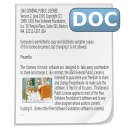Construction of Free Hardware Device for Interaction in 3D Environments
Abstract
This article presents two models of design and construction of a device for the simulation of the movements and interaction of the upper and lower limbs in three-dimensional environments (Virtual Reality device), through the use of free technologies. The Arduino hardware platform is used as the physical data acquisition center. The selection of sensors and actuators is carried out, as well as an analysis of their feasibility and functionality.
Downloads
References
A. L. García, “Realidad virtual,” Universidad Complutense de Madrid, Servicio de Publicaciones, 2004.
M. Kim, C. Jeon and J. Kim, “A study on immersion and presence of a portable hand haptic system for immersive virtual reality,” Sensors, vol. 17, no. 5, p. 1141, 2017. DOI: https://doi.org/10.3390/s17051141
O. Bamodu and X. M. Ye, “Virtual reality and virtual reality system components,” Advanced materials research, 2013, vol. 765, pp. 1169-1172. DOI: https://doi.org/10.4028/www.scientific.net/AMR.765-767.1169
M. Edwards, “Virtual reality system including smart objects,” Google Patents, 2013.
V. Oculus, LLC, Oculus Gear VR.
M. Borges, A. Symington, B. Coltin, T. Smith and R. Ventura, “Htc vive: Analysis and accuracy improvement,” 2018 IEEE/RSJ International Conference on Intelligent Robots and Systems (IROS), 2018, pp. 2610-2615. DOI: https://doi.org/10.1109/IROS.2018.8593707
M. G. Solid, “Sony Playstation,” Tokyo, Japan: Konami Computer Entertainment, Inc, 1998.
C. Hillmann, “Comparing the Gear VR, Oculus Go, and Oculus Quest,” Unreal for Mobile and Standalone VR, Springer, 2019, pp. 141–167. DOI: https://doi.org/10.1007/978-1-4842-4360-2_5
V. Bharath and R. Patil, “Solid modelling interaction with sensors for virtual reality welding,” MATEC Web of Conferences, 2018, vol. 144, p. 1008. DOI: https://doi.org/10.1051/matecconf/201814401008
M. Latarjet and L. Testut, “Compendio de anatomía descriptiva,” Masson, 1997.
J. Sobotta, “Atlas de anatomía humana: Cabeza, cuello, miembro superior,” Ed. Médica Panamericana, vol. 1, 2006.
N. A. DFreitas, “Cinematica Articular,” Revista de la Sociedad Venezolana de Ciencias Morfológicas, vol. 18, no. 1, pp. 15-20, 2012.
J. Martín, “Cinética articular del hombro. Revisión de una década de investigaciones,” Fisioterapia, vol. 23, pp. 9-14, 2001. DOI: https://doi.org/10.1016/S0211-5638(01)72962-8
U. G. Engine, “Unity game engine-official site,” [Online] Available: http://unity3d. com, pp. 1534-4320, 2008.
B. Sensortec, “Intelligent 9-axis absolute orientation sensor,” BNO055 datasheet, 2014.
D. Fedorov, A. Y. Ivoilov, V. Zhmud and V. Trubin, “Using of measuring system MPU6050 for the determination of the angular velocities and linear accelerations,” Automatics & Software Enginery, vol. 11, no. 1, pp. 75-80, 2015. DOI: https://doi.org/10.6000/2371-1647.2015.01.07
S. A. Arduino, “Arduino,” Arduino LLC, 2015.
A. Kurniawan, “Introduction to Arduino Boards and Development,” en Arduino Programming with. NET and Sketch, Springer, 2017, pp. 1-19. DOI: https://doi.org/10.1007/978-1-4842-2659-9_1
D. Lastra Lamarca and others, “Modelo analógico y digital en SystemC-AMS de la placa Arduino Mega 2560,” 2015.
C. Arduino, “Arduino Software,” [Online], Available: https://www. arduino. cc/en/Main/Software.
Copyright (c) 2021 Innovation and Software

This work is licensed under a Creative Commons Attribution 4.0 International License.
The authors exclusively grant the right to publish their article to the Innovation and Software Journal, which may formally edit or modify the approved text to comply with their own editorial standards and with universal grammatical standards, prior to publication; Likewise, our journal may translate the approved manuscripts into as many languages as it deems necessary and disseminates them in several countries, always giving public recognition to the author or authors of the research.
























